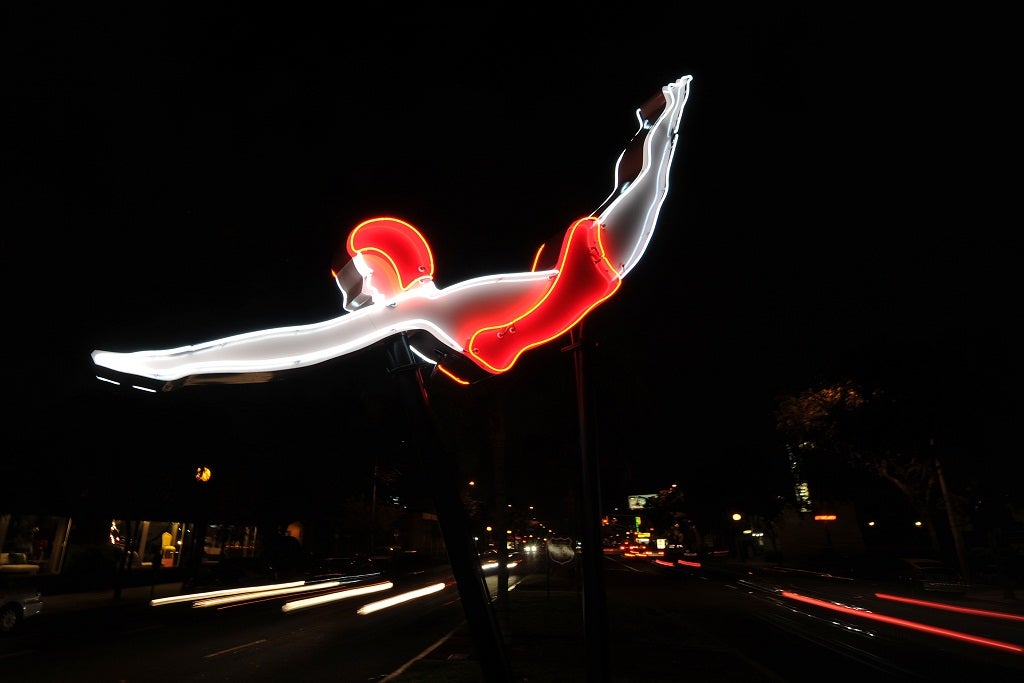What is it about neon on a gallery wall that gets us so switched on?
For transcendence with an on-and-off switch, there's nothing like neon.

If I was an artist, I think I'd work exclusively in neon. In fact it's because I'm not an artist that I'd work in neon, since I can't think of any more forgiving media for a wannabe conceptualist to employ. Video will conceal a multitude of sins, it's true, absorbing any amount of banality and indecision into its grainy surfaces. But for transcendence that comes with an on-off switch, I'm pretty sure that you can't beat neon.
The thought occurred while visiting the Whitechapel's current small exhibition of works by Maurizio Cattelan, a show that includes two neon pieces. In one, the emblem of Italy's 1970s terrorist group Brigate Rosse is rendered as a bright-red Christmas decoration while the other tucks Cattelan's hand written signature into the corner of the gallery space. And both of them are brilliant.
Literally brilliant, I mean, which is, after all, one of the matchless advantages neon can claim. Whether they're brilliant in a more figurative sense, I'm not sure, because it can be quite hard to see past the seductive glare of a neon artwork. They come ready-haloed by incandescent gas, shimmering with a light that is surprisingly easy to mistake for significance. Just think of how readily neon lifts text-based work out of banality and into import. Read “Its not me thats crying Its my soul” in a teenager's exercise book and you wouldn't be likely to nod gravely over the sentiment for very long. But if, like Tracey Emin, you commission a rendering in white neon and persuade a gallery to mount it on the wall, you will probably find that it's been transfigured. Graffitied on a wall the wordplay of “None sing/ Neon sign” might detain you for a few seconds. But render it in red and white neon, as Bruce Nauman did, and you'll surely find that it acquires a new glow and depth.
Nauman was something of a pioneer in this medium, and his text-based works are actually among the best uses of neon. When he wound the phrase “The true artist helps the world by revealing mystic truths” into a spiral of blue neon he was playing with the mass culture associations of the technology, the eye-grabbing vulgarity that made it so indispensable to Las Vegas casinos. The priestly grandiosity of the remark was helpfully knitted to an expression of it that added distance and irony. Am I really being serious, Nauman was suggesting, if I use so frivolous a form? And yet at the same time the form supplied its own inextinguishable nimbus. Why was it so successful as a mass-culture medium? Precisely because it delivers a gleam that the drabber signboards can't and brings to commercial blandishment an aura of other worlds. So Nauman's piece ostensibly says “I have no pretensions” in a language that is all radiant claim.
It's not necessarily a cheat, but it's easy to make it so, to fix a contingent or banal thought in a way that automatically amplifies it. Which may be why the very best neon art doesn't say anything at all, at least explicitly. I guess the title of Dan Flavin's 1963 piece The Diagonal of Personal Ecstasy – a standard commercial yellow tube tilted at an angle of 45 degrees on the gallery wall – makes a kind of claim about the content of the piece. But you don't have to read it, and almost none of his art piggybacks on the qualities of neon to borrow significance for the otherwise trivial. The qualities of neon, that even wash of light and (as importantly) the after image the light leaves behind it, is his subject, and the interpretations aren't tritely there on the wall but waiting to emerge from somewhere in that luminescence. If you were to work in neon, I think it would be Flavin you'd be aiming to match. But it wouldn't be easy. Perhaps I'll stick to unlit words.
Time was when I'd have known
Without giving too much away, Looper, (right) which topped the box-office charts last weekend, is as much about parenthood as it is about time paradoxes. It also put me in a time loop. As a parent you get used to explaining the abstruser plot points of movies to your children but this time I was asking the questions and my teenage daughter was the one answering them. She was also coming up with unanswerable quibbles that would only have occurred to me if I'd spent a couple of hours diagramming the film's plot with coloured marker pens and a large sheet of paper. I'd quite like to travel back in time to when it was the other way round.
Death of Autocue? Not yet
It was intriguing to read the full text of Ed Milliband's conference speech. Although much was made of the fact that he gave the speech without teleprompter, the baleful influence of that device on modern rhetoric was still apparent.
Teleprompters are easiest to use if the text is broken up into short lines, so that, along with repetition and bullet-point lists, has become the prevailing mode in public address. "My parents didn't talk much about their early lives: it was too painful, it hurt too much. The pain of those they lost. The guilt of the survivors," the Labour leader said.
Nobody naturally uses such verb-less sentences. There might not have been an Autocue in the hall, but it was still there in the prose style.
Join our commenting forum
Join thought-provoking conversations, follow other Independent readers and see their replies
Comments
Bookmark popover
Removed from bookmarks